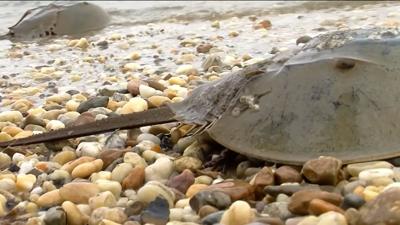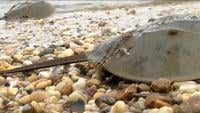BIG STONE BEACH, DE- Big Stone Beach has joined the growing list of Delaware communities committed to protecting horseshoe crabs, becoming the newest addition to the Ecological Research and Development Group's (ERDG) "Backyard Stewardship Sanctuary" program.
This community-led conservation effort marks a significant step in safeguarding the ancient creatures that have long called the Delaware coastline home.
Each year, nearly 460,000 horseshoe crabs are harvested for bait along Delaware’s beaches. While the Delaware Department of Natural Resources and Environmental Control (DNREC) requires harvesters to obtain written permission from property owners, not all follow these guidelines, leading to illegal harvesting practices.
Nancy Hofmann, a longtime Big Stone Beach resident, witnessed this firsthand.
"We watched some fella harvest tens of thousands of horseshoe crabs, loading them into a container for bait."
Motivated to protect the crabs from further exploitation, she and her husband turned to ERDG for help.
The Ecological Research and Development Group, led by Glenn Gauvry, is a Delaware-based organization founded in the 1990s.
"It was logical to start here and move up the Delaware beaches because most of the spawning happens in peoples backyards."
This organization has long worked to conserve horseshoe crabs through its community-focused "Backyard Stewardship Sanctuary" program. The initiative empowers coastal residents to preserve local spawning grounds and create protected zones by rallying neighborhood support.
Big Stone Beach had been on ERDG’s radar for years, but the program’s success depends on the cooperation of residents. Hofmann and a few others, took it upon themselves to spearhead the local movement, working tirelessly to engage their neighbors.
"We mailed information to everyone in the community. For those who didn’t sign, we followed up. I knocked on doors, saying, ‘Come on, it’s important,’”
Through persistence and a shared sense of community, the residents of Big Stone Beach came together for the horseshoe crabs.
Because of the efforts of the entire Big Stone Beach community, Big Stone Beach was added to ERDG’s network of 10 other community-led horseshoe crab sanctuaries along Delaware’s coast. This inclusion ensures that no horseshoe crab harvesting will occur in the area, protecting vital spawning grounds.
Glenn Gauvry is thrilled to welcome Big Stone Beach as the latest community led horseshoe crab sanctuary.
"We’re very proud of it because its a cool little community that has a pristine amount of spawning beaches. It is nice to know that these people here are going to be stewards of that resource."
A sign was installed on the beach in August that gives visitors a chance to learn and read about horseshoe crabs. This information gives people in the community a way to educate themselves on this 445 million year old species.
In addition to providing educational information about horseshoe crabs, the sign also highlights why this area joined the ERDG community-led sanctuary program. These details emphasize what makes this particular beach stand out in its dedication to conservation efforts, showcasing the community's personal commitment to protecting the species.



